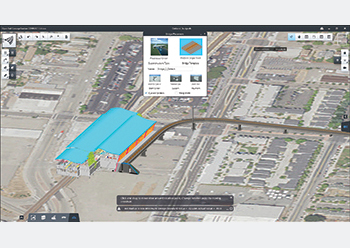 Bentley’s OpenRail ensures BIM’s full potential is realised during project delivery.
Bentley’s OpenRail ensures BIM’s full potential is realised during project delivery.
Known for overrunning their budgets, large project owners are being urged to embrace building information modelling (BIM) methodologies, which can transform traditional project management into a truly collaborative environment that enables on-time and on-budget delivery of projects.
In an interview with ABDULAZIZ KHATTAK of Gulf Construction, Steve Cockerell, industry marketing director rail at Bentley Systems, says cost overruns on projects are a perennial problem.
He cites Bent Flyvbjerg, one of the most cited scholars on megaproject management and a professor at Oxford University Saïd Business School, who estimates that nine out of 10 projects costing $1 billion or more go over budget.
 |
|
Cockerell ... promoting BIM. |
An average of 44.7 per cent of rail projects go over budget. Global management consultancy McKinsey estimates bridge and tunnel projects incur an average 35 per cent in cost overrun while road projects have an average of 20 per cent.
Given the numbers involved, it is little wonder that governments around the world are mandating the use of BIM processes on all public infrastructure projects, says Cockerell.
He notes, however, that BIM adoption is more than using the latest digital technology. “It is about the people involved, the processes they follow, and, where appropriate, the supporting technology they use to meet organisational or project objectives.”
Cockerell says it is imperative to adopt digital technologies for projects in today’s world: “Take, for example, the railway sector. Since the construction of the first railways, professionals in the rail and transit industry have focused on improving this method of transportation, trying to make it the safest, fastest, and smartest means of moving people and goods.
“However, in this ever-evolving and connected world and economy, it is not enough to continue working in the same way. Organisations need to meet shorter deadlines within tighter budgets and are under pressure to comply with an increasing number of standards mandated by governments and asset owners. Something needs to change, and digital technologies have the potential to rewrite the rulebook.”
At Bentley, this is called ‘going digital’.
 |
|
Garrett ... creating awareness through Digital Advancement Academy. |
Cockerell says people at the firm understand that going digital might seem daunting or challenging to some organisations, and it will likely require a shift of both business and organisational activities, processes, and competencies. “Without it, however, organisations will never fully realise the potential that digital technology can, and will, deliver. I would go as far as saying how organisations manage the process of going digital will separate them from their peers and competition. Yes, it’s a challenge but it is also a huge opportunity,” he adds.
Cockerell says deploying digital technology on a project can make an incredible difference, and there is a lot of evidence to support that claim.
“For example, Malaysia’s Mass Rapid Transit Corporation (MRT Corp) will be one of the first in Asia to leverage digital solutions throughout the whole asset lifecycle on its Klang Valley Mass Rapid Transit (KVMRT) system’s Sungai Buloh–Serdang–Putrajaya (SSP) line.
“Having mandated that the UK government’s BIM maturity Level 2 be met on the project, MRT Corp enables team members to leverage the same digital workflows outlined in the PAS 1192 suite of standards through an open, connected data environment (CDE) using Bentley technology.”
“This collaborative BIM solution based on Bentley technology has improved design efficiency and is facilitating accurate information sharing to reduce design rework and increase productivity by 35 per cent,” he adds.
A CDE, he says, is a set of cloud-provisioned or on-premises services that enable firms to better manage and access consistent, trusted, and accurate information across the asset lifecycle. It provides seamless synchronisation and sharing of data among all its stakeholders, allowing every project discipline to work dynamically while coordinating the design.
If fully embraced, BIM methodologies can transform traditional project management – where data is unstructured and team members work independently – into a truly collaborative environment that enables on-time and on-budget delivery of projects.
Cockerell says BIM standards and processes rely heavily on a CDE, adding this type of environment allows users to create a single source of truth for information relating to a project or asset.
According to Cockerell, Bentley’s CDE incorporates ProjectWise and AssetWise, which provide improved collaboration and communication within teams to streamline project delivery, as well as integrating configuration and change management best practices. These applications help ensure the delivery of accurate information beyond construction to operations and maintenance.
He says many rail operators are leveraging an OpenRail CDE to ensure that the BIM potential created through digital engineering models can be fully realised during project delivery and asset performance. The result is that all stakeholders can share the benefits of seamless collaboration, improved decision making, and better business outcomes.
An example of the application of Bentley’s OpenRail solution is the new Beijing to Zhangjiakou high-speed railway by China Railway Engineering Consulting Group (CEC). The company – which was responsible for the preliminary and detailed design of the project, as well as the production of construction drawings – implemented a 3D BIM strategy using Bentley’s solution for collaborative design, model review, collision detection, and construction simulation.
“Working in a CDE enabled CEC to unify data for the 56 design sections on this complex project and optimise coordination among the 23 engineering disciplines involved.
“In this case, the combination of integrated applications and a CDE within the OpenRail solution provided CEC team members with real-time access to data, streamlined workflows, reduced rework, and improved efficiency, enabling a three-month saving in design time and about $400,000 in labour costs,” says Cockerell.
With regard to the adoption of digital technologies in the Gulf region, Cockerell notices a clear willingness to not only invite but also absorb the experience gained on global projects on the world-class infrastructure here that governments and the organisations and professionals working for them aspire to deliver.
Meanwhile, Craig Garrett, academies manager at Bentley Institute’s Digital Advancement Academies Dubai, says the Dubai government has mandated BIM methodologies, which is a key step in the adoption and promotion of the process in the region. However, he says, because the mandate does not explain what BIM is or how it should be implemented, the main organisations in the region must answer these questions for themselves.
Garrett says many of the leading organisations in the region have, therefore, adopted standards and practices from other parts of the world, such as the UK.
In general, the market is upskilling and maturing, driven by larger and more complex projects, he adds. However, when it comes to smaller projects, organisations do not always have the available resources to learn about standards and practices for digital advancements. This is where the Digital Advancement Academy fits in.
“We are best placed to address the awareness and educational needs of this workforce, ensuring that they not only benefit from the amazing experience of the larger organisations but also thrive through good, sound, and impartial advice and guidance,” says Garrett.
The Digital Advancement Academy Dubai is one of seven global hub locations. These academies are digitally connected to allow live, interactive engagement between industry experts and leaders worldwide, with recent events featuring experts attending online from the UK, India, Singapore, and China.
Garrett says in just the past six months, approximately 1,320 professionals have engaged across a selection of 120 standard sessions and unique industry events, proving the popularity and success of the academy in Dubai.
The academy in Dubai has an extended reach and this is proved by engagement with clients in Saudi Arabia and Africa in recent months.
“Viewed as a neutral space, many organisations regularly meet (at the academy)and share industry experiences, best practices, and lessons learned. This collaboration occurs while also referencing some of the most unique and challenging projects within the UAE. Expert speakers are regularly involved in delivering content within the academy for the benefit of everyone in attendance,” he adds.








.jpg)




.jpg)




























.jpg)
































